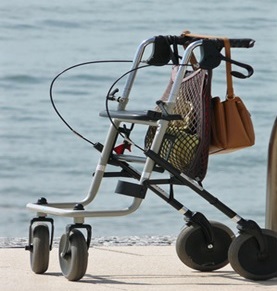the safe handling of The Rollator

All people have a desire to be up in the high age-independent and mobile. In addition to the own motor vehicle, in particular for the elderly public transport such as buses and trams have an important role.
In the following guest post from care work, the safe handling with walkers is discussed.
If the physical force is released, dependent older people is not rare on a Walker as an aid. In the year 1978 by the Swedish social scientist Aina Wifalk invented Walker on four wheels not only allows a high degree of mobility and independence, but also for the Transport of purchases, and allows thanks to the integrated seat even small breathers.
A Rollator, however, not thought out, can be the tool in everyday life a health risk and an obstacle. In order for this to not happen, has selected the care work, the following helpful tips.

The right way to deal with a Walker has to be learned. Image source: Lupo/pixelio.de
Postural prevention
The more often a Walker is used, in order to use the tool as a support, the greater the risk of a “round back”. In the case of the regulation of a Walker should be, therefore, always a briefing that also includes exercise units. Herein, the upright is practiced to Walk with the Rollator, which prevents damage to posture and the correct setting of the Walker.
Orthopaedic surgeons and physiotherapists are able to check the correct setting of the Walker and, if necessary, to adjust. The handles are in a straight state at the height of the wrists. The more secure a user stands on the own legs, the higher the Rollator can be recorded. Thus, the individual settings will not be lost on Walker, markers can be colored adhesive tape. In addition, in the meantime, also offered to walkers, a note of thanks to a built-in memory effect the height adjustment.
Since the use of a Walker, in particular, the shoulder muscles will be used, we recommend regular training sessions. For this to be pulled for a few minutes of the day, for example, the shoulder blades back and down, the arms, then the side lifted and the entire body is then stretched in the upright position. These Exercises are suited to solve muscle tension and the muscles.
Preparation is everything
Any travel with the Rollator should be well prepared. This includes, in a timely manner from home to break. It soothes, to know that in spite of potential detours on a traffic light for safe Crossing of the road is still sufficient time is available.
It can also be worthwhile, prior to the use of public transport more information on the respective vehicles. In the last years, the Travel with trains, trams and buses for those with walkers, wheelchairs, walking difficulties or with children has become a car easier. Increasingly, low-floor vehicles are used, the almost step-free entry and exit are possible.
With the Walker in the Bus & train
When Boarding the Bus or tram, first the front wheels and the rear wheels of the Walker in the vehicle is pushed should be, before self got in. For a to lift the Walker to a lot of force is required, while at the same time, the secure state is compromised. When Exiting the tram or Bus, the stop edge is higher than the exit from the vehicle, it should reverse out and the Rollator will be rescheduled.
For the duration of the journey, it is advisable to look for a place in the direction of travel, as well as in the vicinity of the doors. This can ensure that the regular short holding periods sufficient to get Off. During the travel of the Rollator should be used in the Rest of the never as the seat, so it can not come in the case of unforeseen braking to accidents. On the contrary, the should be attracted to the Parking brakes of the Walker, and only then released again when the means of transport. Also the braking before a stop can affect the balance, which is why the exit in the ideal case, takes place only when the vehicle is in the safe state.
Help Out or Get in, as well as the Seating in the required, should not shy away from the elderly, and other passengers. In the case of the elderly, the use of a 24-hour care is always an accompanying person in the position to accept such aid.
If you want to learn more about rollators, inform yourself here in Detail: Rollator comparison.
